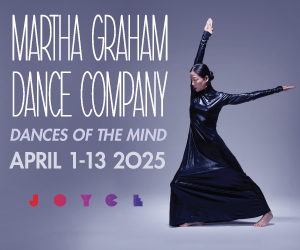IMPRESSIONS FROM CHICAGO: Erin Kilmurray and Kara Brody in "Knockout" at Steppenwolf 1700 Theater

Presented by Lucky Plush Productions
Starring “The Girls” Erin Kilmurray + Kara Brody
With Corey Smith as “Themself”
Directed by Erin Kilmurray + Katrina Dion
Choreography by Erin Kilmurray + Kara Brody
Dramaturgy by Katrina Dion
Sound Design by Corey Smith
Lighting Design by Liz Gomez
Costume Design by Mary Williamson
With creative contributions by Bran Moorhead
Text from a neo-neon-Western-noir-offering for Knockout by morgan mcnaught
“This bitch.”
Dancer and co-choreographer Kara Brody mumbles her insult as she lowers her knees into a crawl, about to begin the next high-impact, WWE-style movement sequence with her dance/fight partner Erin Kilmurray, who has stumbled away to change their shirt. It’s one of those moments in a performance when you can feel the line between art and life crumbling for a second, chuckling at the realness of the side-eye-laden interjection. The mix of camaraderie and disdain between Brody and Kilmurray is both performative and authentic, in the way that Bonnie and Clyde’s rapport is both put-on camp and genuine love story.

Knockout, directed by Kilmurray and dramaturg Katrina Dion and presented by Lucky Plush Productions at Steppenwolf 1700 Theater in Chicago, unfolds as a collage of saturated, high-intensity encounters. Cinematic lighting by Liz Gomez has the scene bouncing from a hot pink rectangle to a top-lit fluorescent, and Corey Smith’s sound design transitions from slapstick action-hero effects to lulling country ballad in the span of a single record scratch. The performers parallel these stark cuts, moving between choreographed fight sequences (kick, kick, fall, somersault) and oozing body rolls pulled out of a dank nightclub (or one of Kilmurray’s Fly Honey shows).
The work carries us on a nostalgic wave of “neo-neon-western noir” (a concept credited to writer morgan mcnaught), landing somewhere akin to the late-80s New Mexican desert of recent lesbian thriller Love Lies Bleeding. I’m grateful to travel here, in need of this dose of queer yearning one week into Trump’s second coming.

For its hour-long run, I succumb to the buckwild pacing of Knockout’s episodic rodeo. When Kilmurray suddenly holds up a glass of water in desperation, I don’t need to know where their emotion comes from; I just witness the intensity of their muscular crying. When Brody pulls them into a tender hug, its brevity reminds me how friendship is the speediest of saves, quickly carrying us into the next adventure. When the encounter later moves to Brody grabbing Kilmurray’s jaw with a rough swivel, I’m reminded that love and pain are duet partners as well.
For all its action-movie intensity, the work’s quotidian gestures hit me hardest: Kilmurray and Brody clinking tall water glasses to toast the beginning of the show with their music and tech collaborators; the pair using those same glasses to throw back shots of water (clink, tap on the floor, swig) while lounging against the upstage wall; each partner playfully removing the pants of the other to reveal a wrestling jockstrap for Brody and mesh underwear for Kilmurray (expertly styled by Mary Williamson).

On the night I’m watching, the only challenge to all this subtlety arises from members of the audience who lovingly burst into a hoot and holler whenever the dancing duo performs a particularly thrilling stunt. This means that I never quite drift off into Knockout’s queer Western wonderland; I find myself always pulled back into the here-and-now of the Steppenwolf Theater. Over time, I come to revel in this oscillation, simultaneously witnessing the real-life community and the phantasmatic performance built by Knockout’s creative team.
This state of in-betweenness renders Knockout a decidedly queer dance — maybe even a dyke dance, if there is such a thing. Traversing sultry gestures reminiscent of gay cruising, cinematic gore, a playful scramble through the audience, and a unison sequence set flat against the wall, this dance doesn’t settle for a single aesthetic or movement lineage. Instead, as choreographers, Brody and Kilmurray take a raucous approach to form, collaging time and space and bits of movement phrases such that I can’t really remember how it ends.

Were they embracing or grappling? Helping or hurting? I don’t need to know. I just wish the world outside this theater could commit to this cycle of hit and hug, ruin and repair. Like Knockout, that’s a show I’d love to watch.











